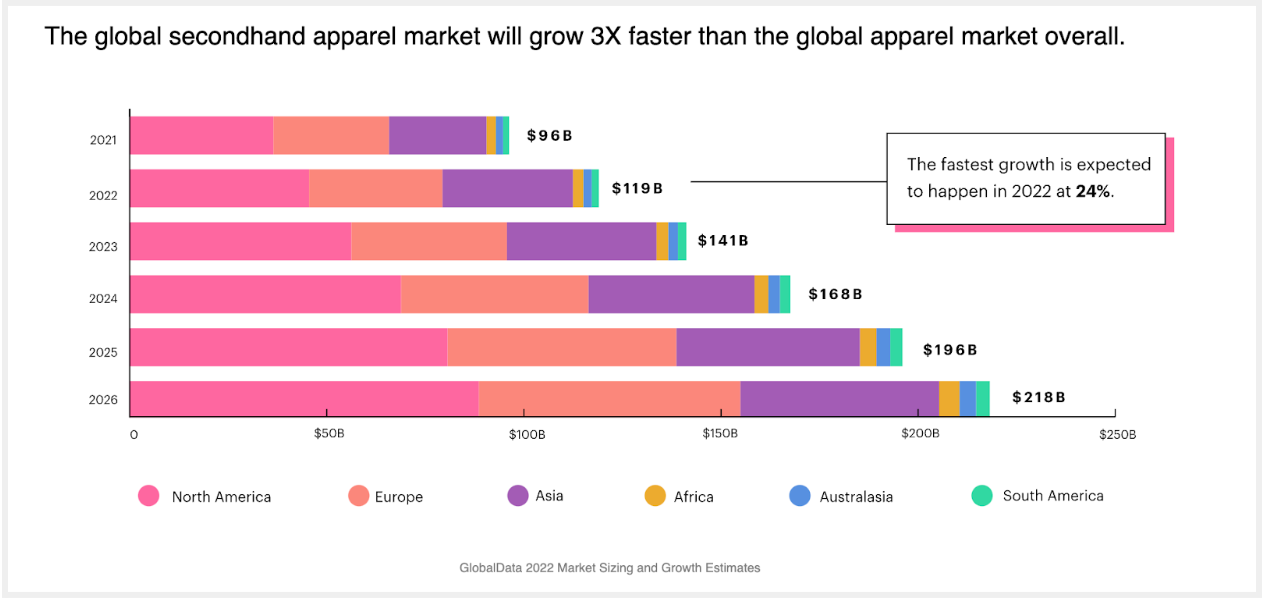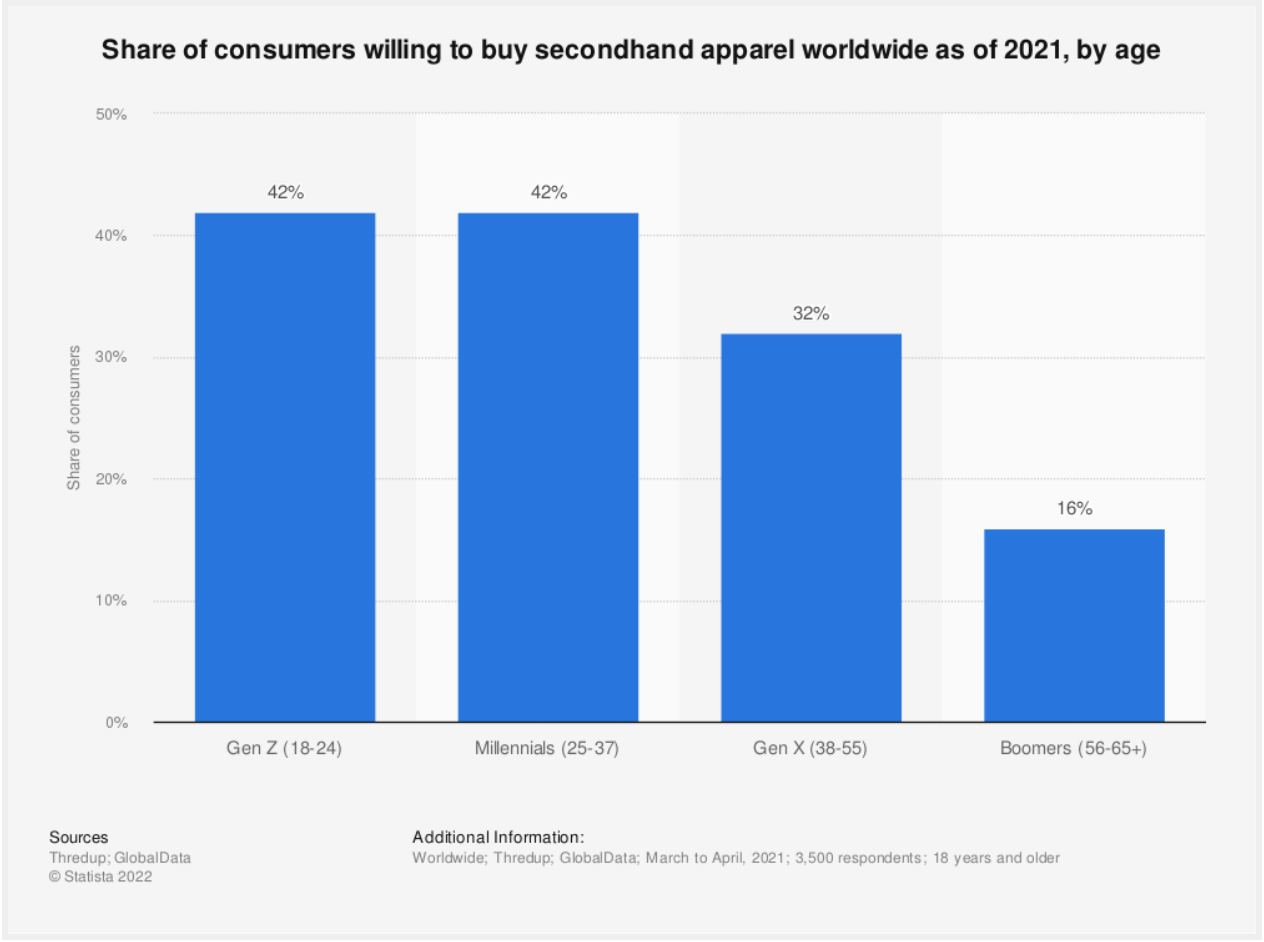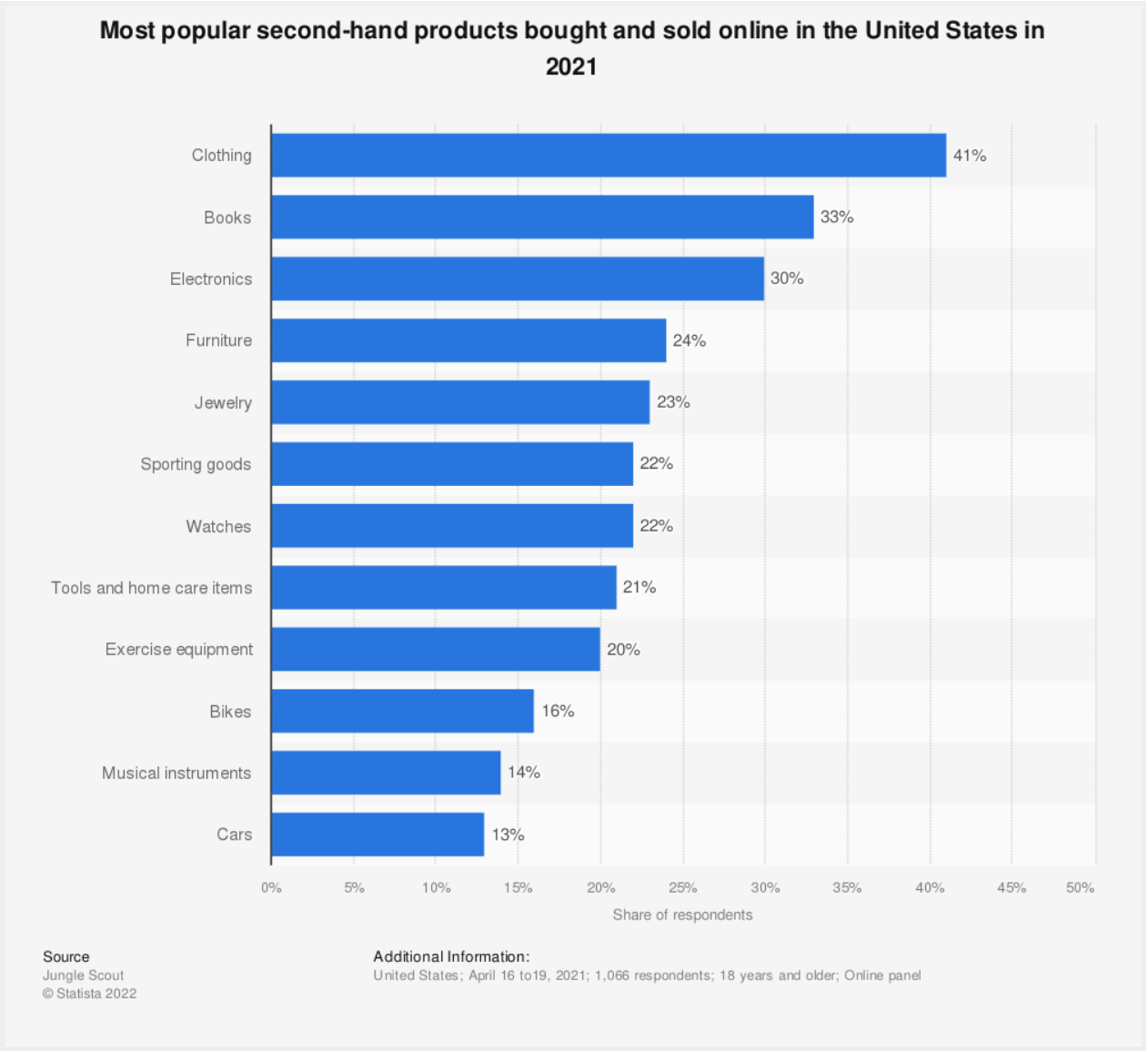Recommerce (or reverse commerce) is the process of selling previously-owned products through physical and online channels.
The last few years have been a turbulent time for retail. There’s the threat of a looming recession. Environmentally-minded consumers are questioning the wastefulness of the fast fashion industry.
Or at least new to them. These factors are helping pave the way for retailers to set up a resale program: buying back old products and giving them a new life. It’s a win/win; customers get the same quality products for a fraction of the cost, and retailers get to generate revenue without generating excess production.
By 2030, the recommerce industry is expected to be worth $84 billion, almost double that of fast fashion. Let’s take a closer look at why this shift is happening and how your store can introduce a resale program.
What is recommerce?
Recommerce typically happens through organized buyback, trade-in or upcycling programs—initiatives that allow customers to return their used products, often in exchange for money or store credit. Retailers then clean up the items and resell them, in-store or online, at a reduced price.
How big is the recommerce market?
The earth is changing, and so is the way consumers shop. With 77% of Americans concerned about the environmental impact of products they buy, retailers are revamping their business models to improve both the planet and their balance sheets.
For years, the fashion industry has faced backlash for its climate-harming practices. Consider these facts:
- One new garment takes 77 gallons of water and creates 17 pounds of CO2 equivalent
- Over 100 billion garments are produced each year, and 73% of all apparel ends up in a landfill is incinerated
- Buying one used item reduces its carbon, waste, and water footprints by 82%
Today, studies show that 272 million people are currently buying or selling secondhand goods. Almost six in 10 Americans who do so plan to increase their recommerce activity over the next year.
As a result, the recommerce and resale market is growing at a rate 11 times faster than the broader retail market—a figure that’s expected to double within the next five years.

The benefits of recommerce
Beyond the sheer volume of the market, here are some of the reasons retail businesses are getting involved with product resales.
- Convert price-sensitive shoppers. Many shoppers are reducing their spending as a result of the recession. Plus, for premium brands, selling used goods is a way to convert more price-sensitive shoppers. Once they’ve tried the item once, it becomes easier to convert them into full-price consumers.
- Cost savings and price control. Instead of manufacturing the same product multiple times for individual customers, resell the same item to several people. It’ll shorten your retail supply chain while maximizing the revenue each item generates.
- Sustainability. To combat fashion’s wastage problem, many retail-focused sustainability initiatives center on moving toward a circular economy, one that emphasizes the repair and recycling of existing materials and products for as long as possible.
- Conscious consumption. As it becomes easier to sell clothes online, people are getting rid of their old clothes and reinvesting the money in more glamorous used items. Apps like Depop and Poshmark have paved the way for modern recommerce services, while simultaneously helping to give birth to the thriving recommerce industry.
- Encourage retention. Once shoppers are in-store, especially returning customers, they’re more likely to buy. Customers are also more inclined to shop knowing that their products have resale value.
“I don’t think we’ve unleashed the creativity [for recommerce] yet. The field is wide open,” says Monica Park, co-founder of circular fashion group Eleven Radius.
“The winners, long-term, will have a very clear, almost-obsessed focus on the customer experience and finding the right incentives to truly reward and shift their habits. This is going to come from people within brands who really understand and care about the customers who buy their products the first time around.”
How does recommerce work?
Types of recommerce
There are three main types of recommerce. Let’s take a look at each one, with an example of when it might be used.
- Buyback. A buyback program encourages people to return their pre-loved items by offering to refund a percentage of the sale price. If someone returns a $29 phone charger, for example, the retailer could offer a $2.90 credit note to redeem on their next purchase.
- Trade-in offers. Get customers to bring back used products by offering a trade-in deal. Apple is one recommerce example. In its retail stores, Apple customers can return used devices in exchange for credit on newer ones.
- Upcycling. An upcycling program reuses old items and turns them into newer products. LUSH Cosmetics, for example, recycles its plastic containers when shoppers use up the product and bring it back in-store. Those old containers are used to sell new products.
Some retailers combine recommerce programs with customer incentives. Take Allbirds, for example. Its partnership with Trove allows the retailer to offer customers $20 in-store credit in exchange for turning in their pre-loved Allbirds shoes. The used shoes are then resold online on the ReRun platform, starting at $59.
This initiative is part of a broader effort around Allbirds Flight Plan, a strong commitment to upholding a more sustainable fashion economy.

Who buys recommerce products?
Data from Thredup shows millennial and Generation Z shoppers are most likely to buy second-hand apparel. The willingness to buy recommerce products seems to decline with age—just 16% of boomers over the age of 56 are open to buying second-hand clothing.
This is partly why recommerce is on the rise. Younger generations have greater purchasing power; it’s estimated that Gen Z consumers make a total of 358 transactions each year, each averaging at $58.30 per transaction. Boomers, on the other hand, spend $60.38 across just 202 transactions.

“I have decided to buy a lot of my Christmas gifts for my friends and family this year from secondhand shops, both in-store and online,” says Maggie Vlasaty, account associate at One Simple Plan.
“I have done this in the past, but I always make a point of shopping at secondhand stores first and foremost, regardless of the occasion. It’s small purchases like shopping secondhand that can truly make an impact in the long run, both environmentally and emotionally.”
What items can you sell as recommerce?
The best items to resell through your store are goods that aren’t perishable and hold a good resale value. That includes:
- Apparel and clothing, particularly baby clothes, which become too small very quickly
- Antiques and collectables, including old coins, stamps, or jewelry
- Used electronics, such as older PCs, video consoles, or smartphones
- Home goods, including furniture, kitchen gadgets, or appliances
- Sporting goods, such as football jerseys, bicycles, or exercise machines
Grace Baena, director of brand of Kaiyo, says, “I recently purchased a refurbished Macbook Air through Apple after the Macbook I’d purchased brand new years ago finally was due to be replaced.
“I have personal experience with the longevity of Mac laptops so I felt comfortable purchasing one used in order to take advantage of the lower price, especially given the fact that even refurbished laptops come with an optional warranty.”
Denim, in particular, can pretty much be worn until it’s falling apart because it’s such a strong fabrication and is meant to wear down and get all that amazing character from being worn over and over again.

Tips for including recommerce in your store
Confirm which products can be resold
Depending on your industry, not all of the products in your retail store will be eligible for recommerce. Items that can’t be resold include:
- Skincare or makeup items
- Hygiene products, such as sanitary items or underwear
- Items with shelf life issues, such as food and drink
(Although these items can’t be resold, you can run an upcycling program to recycle used packaging—especially if it’s made with plastic.)
The best items to resell are products that hold residual value. It’s largely why designer brands often have a resale program. People still aspire to have the social status associated with luxury brands, so they’re willing to splash thousands on a second-hand designer bag. They get the same quality product at a lower price.
Have strict quality control criteria
Just because shoppers are giving old products a new life, it doesn’t mean they’re willing to sacrifice much on quality. Set clear expectations on how refurbished products will function with a grading scale.
If you’re selling refurbished electronics, for example, your grading scale could be as simple as:
- Exceptional: Like new
- Good: Fully functioning, but with minor scratches
- OK: Some elements need repairing
Take lululemon, for example. The athleisure brand operates a Like New resale program to all stores nationwide. Whether online or at any store in the US, customers can exchange their gently used lululemon gear for an online gift card ranging from $5 to $25, depending on the item.
The goods are then resold by lululemon on its Like New platform for nearly 50% off the retail price. Any item that doesn’t meet the predetermined quality standards is recycled through Debrand.
The lululemon resale program will reduce its products’ carbon footprint by up to 50%, and all profits will be directed toward its Impact Agenda. By 2030, lululemon pledges to make 100% of its products with sustainable materials and end-of-use solutions.
Educate customers on the value of recycled goods
While sustainability plays a large role in many purchasing decisions, some consumers may still not be aware of the impact their purchases have on the environment. Educate these people with marketing messages that highlight the value of recommerce.
Take the organic skincare brand Meow Meow Tweet, for example. As part of its unique Bulk Aisle refill program, the retailer encourages its customers to shop in bulk after their first purchase.
By refilling the glass bottle from their first order, buying in bulk reduces the amount of plastic packaging needed for reorders and saves customers money. All bulk purchases are delivered in lightweight aluminum bottles and come with free shipping as an added incentive.
To educate customers on the upside of buying in bulk, Meow Meow Tweet breaks down the Bulk Aisle math that results in each customer saving 255 bottles from landfills and saving $1,575 over a 30-year span.

Host “garage sales” for resale customers
Garage sales and flea markets aren’t things of the past. More than 6.5 million Americans host yard or garage sales each year. Along with flea markets, they help people in the local community buy second-hand products at a fraction of the retail price.
Use the format when introducing recommerce into your retail store. Host a garage sale and use local marketing techniques to drive the local community toward your store. These events can attract people who would otherwise think your products are too expensive.
A retail leader in sustainability, REI has been selling used gear since 2017. Although all shoppers are able to buy pre-owned items, the trade-in option is available only for REI Co-op members. It operates the same way as a standard program: trade in your used gear in exchange for an REI gift card.
REI has also tested pop-up shops, selling only used gear as an expansion of its famous in-store Members Only Garage Sales.
List on recommerce marketplaces
Recommerce marketplaces connect buyers and sellers of second-hand goods. Alongside your brick-and-mortar stores, list pre-loved items on these online marketplaces to attract local shoppers:
The best part? You can use these preloved marketplaces to divert foot traffic to your store. Offer buy online, pick up in-store for marketplace buyers. Once they’re in your store, have a retail salesperson convince them to buy more products.
I’ve bought a handful of household items from Facebook Marketplace–a few chairs, a dresser, and a coffee table. I love using Facebook Marketplace for these kinds of items because it’s a great way to save money while still getting high-quality pieces.
Incorporate recommerce in your store
You may not be in a position to launch a buyback, trade-in, or upcycling program now, and that’s OK. What’s important is that you’re thinking about how to move toward participating in the circular economy.
Quiz your existing customers and ask whether they’d be interested in a resale program—one where they get access to the same quality products for a smaller price. You might open the door to a whole new market, increasing your bottom line while becoming more sustainable.
Get started with Shopify POS
Join Allbirds, Meow Meow Tweet, and other brands using Shopify POS to unlock growth in-store and online and create a unified, modern customer experience.
Read more
- Why Retailers Can’t Ignore The Power Of Sound: Building a Sonic Strategy for Your Store
- Do Retailers Need a Digital Fashion Strategy? 5 Brands Designing for the Metaverse
- Why People Buy: 5 Aspirational Marketing Tactics for Retail Brands
- The Future of Retail Staff: How Is the Role of the Retail Worker Changing?
- Complete Retail Automation Strategy Guide for 2002
- How to Build Your Own Homemade Business With Craft Kits
Recommerce FAQ
What is the meaning of recommerce?
How do I start a recommerce business?
- Choose a pre-owned product to sell
- Price your product competitively
- List it for sale on resale marketplace
- Open an online store or retail location
- Advertise the pre-loved goods





